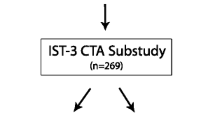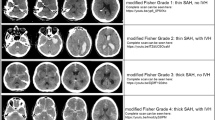Abstract
Background
In patients with SAH the amount of extravasated blood on the initial CT scan is related with delayed cerebral ischemia and clinical outcome. We investigated the interobserver variation of the Hijdra and Fisher scales for the amount of extravasated blood and the predictive values of these scales for delayed cerebral ischemia and outcome.
Methods
For 132 patients admitted within 48 hours after SAH three observers assessed the amount of blood on the initial CT scan by means of the Hijdra and Fisher scale. We analyzed interobserver agreement with kappa statistics and used multivariate logistic regression for the association with delayed cerebral ischemia and clinical outcome.
Results
The interobserver agreement of all three pairs of observers was good for the Hijdra scale (kappas for total sum scores ranging from 0.67 to 0.75) and mild to moderate for the Fisher scale (kappas ranging from 0.37 to 0.55). For the Hijdra scale the risk of DCI was higher for intermediate (OR 4.2; 95% CI 1.1–16.3) and large (OR 3.6; 95% CI 0.8–16.4) amounts of blood with small amount as reference. Fisher grade III (OR 1.0; 95% CI 0.2–5.2) and IV (OR 0.3; 95% CI 0.02–4.0) were not related with DCI. For the Hijdra scale and clinical outcome we found an increasing risk for poor outcome with intermediate (OR 3.9; 95% CI 1.0–15.9) and large (OR 10.7; 95% CI 2.3–50.1) amounts of blood. Such a relation was not found for Fisher grade III (OR 1.2; 95% CI 0.2–7.0) and IV (OR 0.2; 95% CI 0.01–3.4).
Conclusions
For the Hijdra scale we found a distinct better interobserver agreement than for the Fisher score. Moreover, the Hijdra scale was an independent prognosticator for DCI and clinical outcome, which was not the case for the Fisher score.
Similar content being viewed by others
References
Adams HP Jr, Kassell NF, Torner JC, Haley EC Jr (1987) Predicting cerebral ischemia after aneurysmal subarachnoid hemorrhage: influences of clinical condition, CT results, and antifibrinolytic therapy. A report of the Cooperative Aneurysm Study. Neurology 37:1586–1591
Claassen J, Bernardini GL, Kreiter K, Bates J, Du YE, Copeland D, Connolly ES, Mayer SA (2001) Effect of cisternal and ventricular blood on risk of delayed cerebral ischemia after subarachnoid hemorrhage. The Fisher scale revisited. Stroke 32:2012–2020
Drake CG, Hunt WE, Sano K, Kasell N, Teasdale G, Pertviset B et al. (1988) Report of World Federation of Neurological Surgeons Comittee on a universal subarachnoid hemorrhage grading scale. J Neurosurg 68:985–986
Fisher CM, Kistler JP, Davis JM (1980) Relation of cerebral vasospasm to subarachnoid hemorrhage visualized by computerized tomographic scanning. Neurosurgery 6:1–9
Fleiss JL (1981) Statistical methods for rates and proportions. 2nd ed. Wiley-Interscience, New York
Hijdra A, Brouwers PJ, Vermeulen M, van Gijn J (1990) Grading the amount of blood on computed tomograms after subarachnoid hemorrhage. Stroke 21:1156–1161
Hijdra A, van Gijn J, Nagelkerke NJ, Vermeulen M, van Crevel H (1988) Prediction of delayed cerebral ischemia, rebleeding, and outcome after aneurysmal subarachnoid hemorrhage. Stroke 19:1250–1256
Hop JW, Rinkel GJE, Algra A, van Gijn J (1997) Case-fatility rates and functional outcome after subarachnoid hemorrhage. Stroke 28:660–664
Jennett B, Bond M (1975) Assessment of outcome after severe brain damage: a practical scale. Lancet 1:480–484
Landis RJ, Koch GG (1977) The measurement of observer agreement for categorical data. Biometrics 33:159–174
Qureshi AI, Sung GY, Razumovsky AY, Lane K, Straw RN, Ulatowsky JA (2000) Early identification of patients at risk for symptomatic vasospasm after aneurysmal subarachnoid hemorrhage. Critl Care Med 28:984–990
Rinkel GJE, Wijdicks EFM, Vermeulen M, Ramos LMP, Tanghe HL, Hasan D, Meiners LC, van Gijn J (1991) Nonaneurysmal perimescencephalic subarachnoid hemorrhage: CT and MR patterns that differ from aneurysmal rupture. Am J Neuroradiol 12:829–834
Van der Jagt M, Hasan D, Bijvoet HWC, Pieterman H, Koudstaal PJ, Avezaat CJJ (2000) Interobserver variability of cisternal blood on CT after aneurysmal subarchnoid hemorrhage. Neurology 54:2156–2158
Author information
Authors and Affiliations
Corresponding author
Additional information
Received in revised form: 9 February 2006
Rights and permissions
About this article
Cite this article
van Norden, A.G., van Dijk, G.W., van Huizen, M.D. et al. Interobserver agreement and predictive value for outcome of two rating scales for the amount of extravasated blood after aneurysmal subarachnoid haemorrhage. J Neurol 253, 1217–1220 (2006). https://doi.org/10.1007/s00415-006-0205-0
Received:
Accepted:
Published:
Issue Date:
DOI: https://doi.org/10.1007/s00415-006-0205-0




